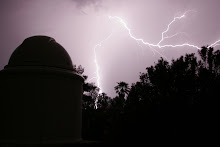
Last night I attended the TAAA meeting with my friends Larry and Andy. The program was excellent - both the beginner's lecture and main session were about astrophotography. Needless to say I saw many outstanding amateur astro images. Also needless to say I was inspired to work a little harder at getting some nice output from my ccd camera, which really has not had nearly enough use since I acquired it last summer.
I feel so fortunate to be in a hobby where other enthusiasts love to share their experiences and knowledge. The TAAA meetings are always fun - plus, for the first time I actually won one of the door prizes! I won a Starry Night Screensaver.
Anyway I came home and opened the dome - it was late, about 10:30 when I got home. Skies were clear but my intention was to grab some images of asteroids 11 Parthenope and 16 Psyche (I'm trying to get their motion again since my first attempt was not exactly a success...) and then get some sleep. I'm quite exhausted after a long week of hard work and several nights staying up late in the dome.
However, after imaging the asteroids (I'll post more about that later), I just could not resist going after another target, since the seeing was quite good, or at least my focus was better than I've been getting. So I slewed over to one of my favorite deep-sky objects, NGC 2419, a.k.a. The Intergalactic Wanderer, a.k.a. Caldwell 25, a.k.a. Levy 195. The famous Harlow Shapley called it the Intergalactic Tramp. It's a faint globular cluster. This image is a combination of 5 each of R,G,B, and Clear 15 second images, 2x2 binning. If you look closely you will see some star trailing - I was not guiding. The brightest star is SAO 60232, and only looks big because its light saturated the ccd chip. Anyway it's kind of fun for me to capture my old friend the Wanderer in a picture. With autoguiding I probably could have increased the exposure time and got a better picture, that will have to be another night.

No comments:
Post a Comment